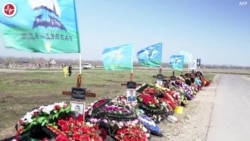On September 21, Defense Minister Sergey Shoigu said that just under 6,000 Russian soldiers had died in Ukraine since his country invaded its neighbor in late February.
“Our losses to date are 5,937 dead,” Russia’s RT state broadcaster quoted Shoigu as saying on September 21, the day Russian President Vladimir Putin announced a “partial mobilization” that would muster 300,000 reservists and others into the ranks to continue the war.
Shoigu’s figure is likely false based on multiple estimates from western intelligence services, Ukraine, and independent analysts who are carefully following the fighting.
Ukraine officials have cited about 10,000 dead on their side. To be sure, all outside estimates involve uncertainty and guesswork given the ongoing fighting. But Russia’s figures appear to be far lower and out of scale compared to Putin’s mobilization.
Shoigu said the additional troops were needed to “hold the line at the front” in Ukraine. But if only 5,937 Russian troops have died in Ukraine over seven months, then why call up 50 times as many new soldiers to replace them?
Earlier, Russia said the war was proceeding according to plan and that no mobilization would be needed. But in early September, a surprise Ukrainian offensive steamrolled Russian troops in the northeast around Kharkiv, liberating thousands of square kilometers of territory in two weeks.
Shoigu did not cite a number of wounded but claimed "more than 90% returned to duty."
What do some of the competing casualty estimates say?
Based on open sources, the BBC reported that from February 24 to September 16, 6,476 Russian soldiers and officers had died in Ukraine. But while that’s close to Russia’s figure, the BBC added an important caveat: It counted only confirmed government and media reports of deaths, and thus likely did not capture the true number.
"Every week we find new evidence of Russian military funerals in different localities of Russia, which are not reported by local authorities,” the BBC said. It concluded that a more likely estimate of dead Russian troops was 1.5 times higher – or around 10,000.
Western intelligence and defense ministries have issued higher estimates.
The head of Britain's armed forces, Adm. Antony Radakin, said in mid-July that some 50,000 Russian troops had been killed or wounded, with nearly 1,700 tanks destroyed.
Using the historic wartime ratio of wounded to dead of roughly 3 to 1, that would mean 12,500 Russian soldiers had lost their lives as of mid-July. Better battlefield medicine has improved that ratio for the U.S. military, but it’s unclear if that's true for Russian forces.
On July 20, CIA Director William Burns said the U.S. intelligence community estimated that after five months of the war, 15,000 Russian forces had been killed and “perhaps” 45,000 wounded in Ukraine.
Likewise, Estonian Foreign Intelligence Service Director Mikk Marran estimated that some 15,000 Russian servicemen had been killed in action in Ukraine. “According to our assessment, we consider 60,000 Russians [are] out of business in one way or another,” he said on July 20.
Richard Moore, the head of the MI6, Britain’s foreign intelligence service, told reporters that Russia and Ukraine each were losing about 100 soldiers daily. He, too, estimated the Russian losses at 15,000 until that point.
Burns, Marran and Moore all discussed their estimates at the Aspen Security Forum in Colorado.
On August 8, Colin Kahl, the U.S. Under Secretary of Defense for Political Affairs, said between 70,000 and 80,000 Russian troops had been wounded or killed in less than six months of fighting in Ukraine. The Pentagon estimated the death toll at 20,000.
That assessment was based on analysis of satellite imagery, message intercepts, social media posts and local media reports, officials told reporters.
Russian losses increased in early September during Ukraine’s counteroffensive.
From September 1 to September 11, citing Ukrainian defense sources, Forbes reported that the Russian army lost at least a battalion's worth of equipment and soldiers every day, meaning hundreds killed and wounded:
“In just under two weeks of brutal fighting, the Ukrainians have destroyed, badly damaged or captured 1,120 Russian tanks, fighting vehicles, artillery systems, trucks, helicopters, warplanes and drones, according to the Ukrainian general staff. Independent analysts scouring social media for photos and videos have confirmed nearly 400 of the Russian losses.
“Around 5,500 Russian troops have died in Ukraine since Aug. 29, according to Ukrainian officials. It’s possible the Ukrainians are overstating the death toll, but it’s worth noting that recent U.S. estimates of Russian losses have been only slightly lower than Ukrainian estimates.”
According to the Armed Forces of Ukraine, 55,510 Russian personnel had been killed in the war as of September 22.
On the first day after the announcement of military mobilization, Russian opposition politicians and movements called on Russians to take to the streets of cities.
Protest actions were held in more than 30 cities in Russia, but compared to the actions of previous years, they were not numerous. More than 1,000 protesters were detained by the police, news reports said.
In Moscow, those arrested for actions against mobilization were handed summons to the military registration and enlistment offices.






